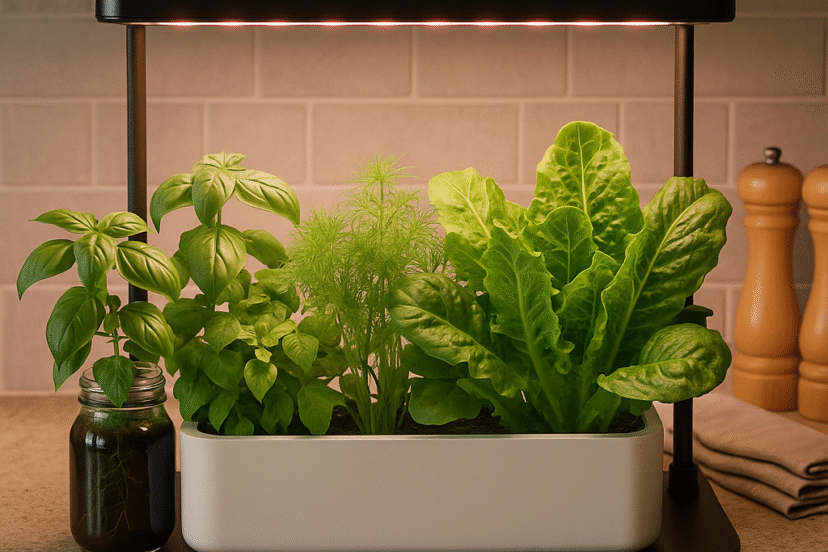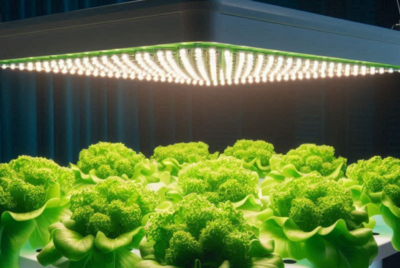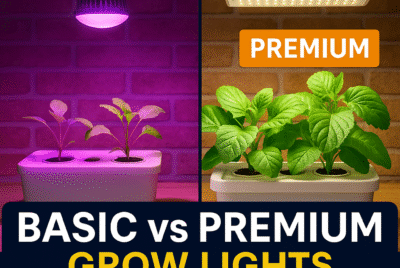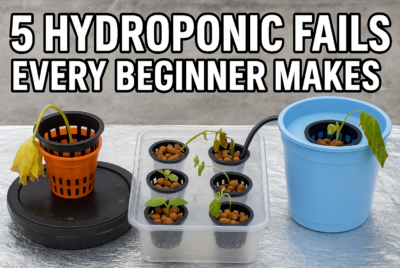5 Trends Shaping Hydroponics in 2025 | Urban Gardening Guide
1. Back-to-Basics Hydroponics for Beginners 🌱
Simple, soil-free systems like Kratky and Wick are booming — here’s why passive hydroponics is taking over windowsills and countertops in 2025.
Hydroponics may sound futuristic, but in 2025, the biggest trend isn’t high-tech towers or AI-controlled fogponics. It’s going back to basics — and making indoor gardening radically accessible to everyone. From students in dorm rooms to retirees in small apartments, thousands of people are discovering that you don’t need fancy gear or deep pockets to grow your own herbs and veggies indoors. All you need is water, nutrients, a container… and curiosity.
🌿 Why Passive Systems Are So Popular
At the heart of this trend are two soil-free systems that have become go-to favourites for beginners: Kratky and the Wick System. Both are considered “passive” hydroponics, meaning they don’t require electricity, pumps, or complicated timers. They’re quiet, inexpensive, and easy to manage — a perfect starting point for first-time growers.
These methods remove the barriers that once kept hydroponics in the realm of science classrooms and high-tech greenhouses. There are no moving parts, no noise, and no electricity bills. Instead, passive hydroponics allows nature to do the heavy lifting while you enjoy the results — often in less than 30 days from seed to harvest.
🥬 What Is the Kratky Method?
Imagine this: a jar of nutrient-rich water, a net cup holding a plant, and a lid that supports the whole setup. As the plant consumes the water, the level drops, exposing more of the roots to air. This creates a natural oxygen zone, eliminating the need for an air pump.
This is the essence of the Kratky method, named after Dr. Bernard Kratky from the University of Hawaii. It’s one of the most low-maintenance systems in hydroponics — perfect for growing leafy greens like lettuce, basil, spinach, or arugula.
Why it works: The roots receive nutrients from the water below and oxygen from the air above. It’s a self-balancing system — set it and forget it!
🛒 Recommended Kit:
Pro Tip: Place your Kratky jars on a sunny windowsill or under a basic LED grow light. You’ll be amazed how fast things grow!
🪴 What Is the Wick System?
Similar in simplicity but slightly more versatile is the Wick System. Here, a cotton rope (or nylon wick) runs from a water reservoir to the plant’s growing medium, slowly drawing up nutrients via capillary action. The plant stays hydrated without being waterlogged.
Wick systems are great for herbs and small leafy greens. They’re especially useful for people who want to leave the system unattended for days — think of it as a self-watering pot on steroids.
Best used for: Mint, parsley, oregano, microgreens, and starter seedlings.
🛒 Recommended Starter:
💡 Why This Simplicity Matters in 2025
In a world increasingly complicated by tech, supply chain issues, and rising food prices, simple is powerful. Passive hydroponics delivers fresh, affordable produce with almost zero upkeep. It’s an empowering experience — no more paying $5 for wilting basil at the supermarket.
And with so many people working from home or downsizing to urban apartments, countertop gardening offers not just food but joy, colour, and life. Many new growers describe it as therapeutic, educational, and even addictive!
📦 What You Need to Start
You can build a basic Kratky or wick system with just a few items:
- 1 container or mason jar (dark glass or wrapped to block light)
- 1 net cup (holds the plant in place)
- Hydroponic nutrients (like Flora Series or Humboldts)
- Starter plant or seeds (lettuce, basil, mint, etc.)
- Optional: LED grow light if sunlight is limited
Total cost? Under $40 for your first grow. No soil, no pests, no mess.
🎓 Urban House & Garden Tip
Start with lettuce. It’s fast-growing, low-maintenance, and rewarding. You’ll be harvesting leaves within weeks. Don’t forget to download our free eBook Hydroponics Starter Kit Handbook for a full beginner walkthrough.
📈 Why This Trend Will Continue
With climate concerns, food shortages, and an uptick in wellness culture, expect even more households to embrace passive hydroponics in 2025 and beyond. It aligns with what people want: healthier habits, less waste, and more control over what they eat.
For schools, retirees, or parents looking for a fun science project — Kratky and Wick systems are affordable entry points into a rewarding new world. It’s gardening reinvented for modern life.
Coming up next: Vertical Farming Goes Home →
2. Vertical Farming Goes Home 🌇🌿
Goodbye backyard, hello wall garden. Here’s how vertical hydroponics is transforming small spaces into productive, modern farms — no soil required.
Urban gardening is going vertical — and fast. What began as a commercial trend in high-tech warehouses is now a booming household movement in 2025. Thanks to the fusion of compact design, LED lighting, and innovative hydroponic engineering, vertical farming is now within reach for anyone with a spare wall or corner.
Whether you’re living in a downtown apartment, a studio flat, or a shared house with no garden space, vertical hydroponic systems offer a smart, stylish way to grow fresh herbs, leafy greens, and even strawberries — indoors, year-round.
🌱 What Is Vertical Hydroponic Farming?
In simple terms, vertical hydroponics is about growing upward instead of outward. Rather than using rows of soil beds or horizontal planters, vertical systems stack plants vertically — using towers, shelves, or wall-mounted channels — and deliver water and nutrients directly to the roots via hydroponic systems like NFT (Nutrient Film Technique), drip irrigation, or aeroponics.
Think of it as farming in 3D. You multiply your harvest potential without expanding your footprint — perfect for tight spaces.
🏢 Big Tech Meets Small Living
In 2025, a new wave of consumer-friendly systems are redefining what indoor vertical farming looks like. Sleek, plug-and-play designs now blend right into modern interiors, doubling as decor pieces while quietly producing salad greens.
Two standout examples from this year include:
- Just Vertical’s AEVA Tower – This Canadian-designed system grows up to 16 plants vertically in a single unit, includes full-spectrum LED lighting, and even functions as a furniture piece with built-in wood paneling.
- Vertefarm’s Micro Plant Factory – Designed for small homes, this futuristic unit supports dozens of plants using a drip-fed vertical surface and includes water sterilisation, app control, and zero soil mess.
These aren’t hobbyist hacks — they’re fully functional food systems disguised as minimalist art. It’s no wonder apartment dwellers, young professionals, and design-savvy homeowners are jumping onboard.
🛠️ DIY? Absolutely.
Not ready to drop $799 on a tech-integrated system? You’re not alone. A growing community of DIY hydroponic enthusiasts are building their own vertical gardens with PVC pipes, stacking bins, and drip lines.
Here are three simple approaches to try:
- PVC NFT Channels – Stack 2–4 levels of PVC channels mounted on a wall, pump nutrient solution through them in a loop, and let gravity do the work. Ideal for lettuces and herbs.
- Stackable Bucket Towers – Drill net cup holes in food-safe buckets, stack them vertically, and insert a submersible pump for continuous flow. Great for larger plants like strawberries or spinach.
- Bookshelf Grow Racks – Repurpose a simple shelf or baker’s rack into a multi-layered farm. Add LED strips and small reservoir tanks for each layer.
🛒 Top-Rated Vertical Systems on Amazon:
- Aerospring 27-Plant Vertical Garden System
- Just Vertical AEVA Countertop Grow Tower
- Gardyn Home Kit 3.0 – App-Controlled Indoor Garden
💡 Why Vertical Wins in 2025
More people are growing food indoors than ever before. But square footage is limited, especially in cities. Vertical systems make it possible to grow 10x more produce in the same footprint. Combine that with smart lighting and minimal water use, and it’s easy to see why this trend is taking off.
Plus, in a world focused on aesthetics and functionality, vertical gardens tick every box:
- ✔️ Space-efficient for apartments and flats
- ✔️ Stylish — doubles as living wall art
- ✔️ Quiet, clean, and energy-efficient
- ✔️ Scalable from 4 to 36+ plant units
Vertical farming isn’t just a convenience — it’s a revolution. It’s putting hyperlocal food production in your kitchen, hallway, or balcony.
📷 From Instagram to Real Life
Social media has played a huge role in normalising vertical gardening. Instagram is filled with aesthetic green walls, while TikTok tutorials show how easy it is to build or maintain a vertical hydroponic rack. Influencers have made it “cool” to grow kale at home — and in doing so, they’ve lowered the barrier to entry for millions.
Our favourite creator, @GrowUpGreens, recently transformed a single 2x4ft wall in her New York apartment into a lush farm with basil, kale, and cherry tomatoes — all grown with a vertical drip tower and full-spectrum LEDs. The harvest? Enough greens to replace store-bought salad bags every week. All without soil, bugs, or plastic packaging.
🌿 Urban House & Garden Tip
If you’re limited on space but serious about growing your own food, vertical hydroponics is your best friend. Start with a low-footprint tower kit or build your own using our free design templates. Going vertical isn’t just a trend — it’s the future of urban food security.
🏁 Summary
Vertical hydroponics takes everything we love about indoor gardening — sustainability, freshness, self-reliance — and adds convenience, efficiency, and beauty. With smart tech, design upgrades, and DIY accessibility, 2025 is the year home-based vertical farms go mainstream.
Whether you’re after food independence, lower grocery bills, or just a greener living space, vertical farming delivers. Stack it. Grow it. Eat it.
Next up: Smart Tech, Lights & Nutrients →
3. Smart Tech, Lights & Nutrients: Hydroponics Gets an Upgrade 🤖💡
Indoor gardening is getting smarter—and more hands-off. In 2025, the hydroponics industry is undergoing a tech revolution that’s making home growing not only easier, but more precise and productive. Thanks to automated systems, smartphone controls, and nutrient optimization, hobbyist growers can now enjoy commercial-grade results right from their kitchen counter.
🌫 Fogponics, Smart Gardens, and CES Highlights
At CES 2025, a standout innovation came from Plantaform, whose Smart Indoor Garden uses fogponics—a method that mists plant roots instead of soaking them. Why does this matter? The fine mist delivers oxygen and nutrients more efficiently, which can accelerate growth by up to 40%. What’s more, the entire system is automated and app-controlled: from adjusting light intensity to managing watering cycles, all tasks are handled digitally. It even alerts you when nutrient levels are low or if your plants need a little extra care.
This is just the tip of the iceberg. Systems like Vertefarm’s vertical units now come with:
- LED lighting systems tuned to optimal photosynthesis ranges
- UV water purification to prevent algae and pathogens
- Built-in sensors to track pH, EC, and temperature
- Smart scheduling to automate your grow routine via smartphone
For beginners, this level of automation removes the guesswork—you don’t need to know the difference between N-P-K ratios or photoperiod cycles. Your smart garden already knows and adjusts in real time.
📱 Hydroponics Meets AI and Mobile Apps
As AI tools continue to filter into the home, smart hydroponic apps are becoming more powerful. Apps like LetPot, Grow With Jane, and Gardyn now feature:
- Nutrient calculators
- AI-driven plant health diagnostics
- Crop tracking and harvest forecasting
- Camera-integrated growth monitoring
For example, LetPot’s system even tells you how much water to refill, when to add nutrients, and offers daily progress visualizations using timelapse images. Some growers joke that their garden sends more notifications than their friends—but that level of support is exactly what beginners need to stay motivated and successful.
🔬 Smarter Nutrients: From Bottles to Biotech
Even the nutrient side of hydroponics has seen a facelift. Gone are the days of mixing three or more bottles like a chemistry lab. Brands like General Hydroponics and FoxFarm now offer all-in-one nutrient blends that are pH-balanced, easy to measure, and require no additional tweaking.
At Indoor Ag-Con 2025, several exhibitors showcased bio-enhanced solutions—nutrients infused with:
- Mycorrhizae fungi
- Beneficial bacteria
- Root-enhancing hormones like IBA
These new formulations not only grow bigger plants but can simulate natural soil biology, helping produce tastier greens with stronger resilience to disease. As more people look for organic and chemical-free alternatives, this biotech-enhanced hydroponics is gaining serious traction.
💡 LED Evolution: Grow Smarter, Not Hotter
Perhaps the most game-changing tech? LED grow lights. These aren’t just energy-efficient—they’re smart. Modern grow lights like the Spider Farmer SF Series and ViparSpectra XS Series now come with:
- Custom light spectrum tuning
- Smart dimming controls
- Timers and sunrise/sunset simulation
- High PPFD for faster plant growth
Older HID or CFL bulbs consumed more power and produced unwanted heat. Today’s LEDs are cooler, last longer, and are tailored for specific plant growth phases (vegetative vs. flowering). For indoor growers, this means:
- Lower power bills
- Less need for cooling or fans
- Better control over plant morphology
🧠 Final Thought: Automation Is Not a Shortcut—It’s a Superpower
Some traditionalists argue that “hands-off gardening” isn’t real gardening. But here’s the truth: automation enhances your control and understanding. It gives beginners a chance to succeed faster and frees up experienced growers to scale.
With smart hydroponics systems in 2025, your plants don’t just survive—they thrive. Whether you’re growing basil in a jar or running a full countertop garden, these tech tools are empowering a new generation of growers. And the best part? You don’t need to be a plant scientist—you just need a smartphone and a desire to grow.
4. Community Buzz: Hydroponics is Trending Online 🚀📱
If it feels like hydroponics is suddenly everywhere, that’s because it is. In 2025, indoor gardening has evolved from a niche hobby into a full-blown social movement—thanks in large part to social media platforms and a growing global community of plant lovers. Whether it’s TikTok, Reddit, YouTube, or Instagram, hydroponics is trending—and people are proud to share their thriving jar gardens, root systems, vertical setups, and leafy harvests with the world.
🌿 TikTok, YouTube & the Rise of DIY Hydro Influencers
The #hydroponics hashtag on TikTok alone has racked up hundreds of millions of views. Why? Because it’s fast, visual, and empowering. Users are sharing:
- Timelapses of lettuce growing on kitchen counters
- Step-by-step Kratky or DWC builds with recycled containers
- Before-and-after harvest transformations
- Reviews of smart hydroponic products and kits
💬 Reddit Threads, Facebook Groups & Community Swaps
Meanwhile, in the text-heavy corners of the internet like Reddit’s r/hydroponics or dedicated Facebook Groups, real-time discussion is thriving. These communities offer:
- Troubleshooting help (“Why are my roots brown?”)
- Growth logs and photos for feedback
- Product comparisons and user reviews
- Free resource sharing like nutrient calculators and pH charts
Whether you’re a total newbie or a seasoned indoor farmer, these spaces offer supportive, crowdsourced advice. One Reddit user recently shared a photo of their DIY lettuce rig made entirely from thrift store finds—within hours, dozens of commenters jumped in to help tweak the design, adjust nutrient ratios, and celebrate the ingenuity. Hydroponics has become collaborative.
🔥 The AeroGarden News: A Catalyst for Conversation
Earlier this year, the announcement that AeroGarden was ceasing operations shocked the community. As a pioneer in countertop hydroponics, their sleek kits had become a household staple. But instead of deterring enthusiasm, the news sparked an explosion of discussion across forums and YouTube channels.
Users began asking: “What are the best alternatives to AeroGarden?” And that question led to deeper exploration. Brands like:
- LetPot – an app-enabled indoor garden system
- iDOO – a compact and budget-friendly hydro kit
- Gardyn – a high-end vertical smart garden with camera monitoring
—all started gaining traction. Enthusiasts traded pros and cons, posted unboxing videos, and encouraged each other to explore new tech or DIY builds. In a way, AeroGarden’s decline became a springboard for innovation and community action.
📸 Hashtags, Challenges & “Green Wall” Aesthetics
Beyond education, hydroponics is now part of lifestyle content. Influencers share aesthetic setups featuring lush green walls, sleek countertop farms, and minimalist glass jars lined up on windowsills. These are paired with trending hashtags like #indoorfarm, #livingwall, or #planttok. As a result, hydro setups are becoming design statements—like having an aquarium or art piece that just so happens to feed you.
There are even online hydroponic grow challenges, where users compete to see who can grow the fastest basil or the most lush lettuce using only a recycled container and LED light. These gamified events make learning fun, drive engagement, and keep people coming back for more.
💡 Final Takeaway: Inspiration Is Contagious
We’re living in a moment where plant content has gone viral—and hydroponics is riding that wave. From informative tutorials to satisfying timelapse clips, the internet is teeming with content that educates, inspires, and entertains. But the biggest benefit? Community. You’re never alone in your growing journey.
Whether you’re looking for tips on battling algae or just want to show off your latest harvest, there’s a space for you. So don’t hesitate to engage. Share your wins, ask your questions, and join a growing movement that’s changing how the world thinks about food, space, and sustainability.
5. Homegrown Food Security: Fresh Produce at Your Fingertips 🌍🥬
In 2025, hydroponics is no longer just a hobby—it’s fast becoming a solution to global food challenges. With rising grocery prices, supply chain uncertainties, and growing concerns about food safety, more people are turning to indoor gardening as a reliable way to take control of their own food supply. And hydroponics, with its soil-free simplicity, is leading this charge.
💡 From Food-Inflation to Food-Innovation
Let’s face it—those $5 bundles of herbs at the supermarket are getting harder to justify. Plus, recurring news of contaminated greens or pesticide-laced produce has many asking: Is there a better way? The answer? Yes—grow it yourself.
Hydroponics allows anyone—whether living in a city apartment or a rural home—to grow pesticide-free, fresh vegetables and herbs with minimal space and water. It’s not just about cutting costs; it’s about growing trustworthy, nutrient-dense food with your own hands. And it’s catching on everywhere.
🏡 Home Kits Are Getting Easier and More Accessible
Thanks to consumer demand, companies are stepping up. New home hydroponic kits like the LetPot Smart Indoor Garden or the iDOO Hydroponic Growing System offer plug-and-play systems that take only 10 minutes a week to maintain. These kits typically include:
- Built-in LED grow lights
- Water level indicators
- Automated nutrient cycles
- App or touchscreen controls
They’re sleek, compact, and often quieter than your kitchen fridge—making them perfect for urban homes, classrooms, or retirement centres. One standout example: in Winnipeg, Canada, a retirement village recently installed an indoor hydroponic “grow-op” where seniors now enjoy leafy greens grown on-site, year-round.
👨👩👧👦 Community Projects & School Gardens
The food revolution isn’t happening in isolation. All over the world, hydroponic co-ops, school gardens, and community installations are taking root:
- Basement hydro co-ops: In NYC, residents converted an unused apartment basement into a co-owned vertical lettuce farm using LED towers.
- Classroom STEM kits: Schools in Australia and the UK are introducing hydroponics as hands-on science lessons—teaching biology, sustainability, and nutrition in one go.
- Food pantry integrations: Nonprofits in Canada and the US are installing hydro towers in shelters and pantries to provide fresh produce alongside canned goods.
This trend isn’t just practical—it’s deeply empowering. Hydroponics gives communities control, teaches self-reliance, and sparks hope. With climate change and food insecurity top of mind for many, these systems are more than just gadgets—they’re tools for resilience.
⚡ The Efficiency Advantage
Why is hydroponics so well-suited to solving food challenges? It comes down to resource efficiency. Compared to traditional agriculture, hydroponics uses:
- Up to 90% less water
- No pesticides or herbicides
- Less land space
- Faster growth cycles (30–50% faster in some cases)
These advantages make hydroponics a sustainable and scalable solution—one that even developing countries are adopting in remote or arid regions to fight food scarcity.
🌱 Start Small, Grow Big
You don’t need to launch a community garden to start making an impact. Even growing one pot of lettuce on your windowsill can reduce your reliance on grocery stores and packaged food. Multiply that by a few plants and a few neighbours—and soon you’ve got a mini food network.
And the best part? Hydroponics is flexible. Whether you want to:
- Grow herbs like basil and parsley for cooking
- Raise leafy greens for daily salads
- Or experiment with tomatoes, strawberries, or peppers indoors
—there’s a setup that fits your space, budget, and lifestyle.
🔗 Final Word: Hydroponics as a Path to Freedom
Food security is about more than just survival—it’s about freedom, health, and dignity. Hydroponics lets you opt out of fragile supply chains, avoid toxic pesticides, and take pride in the food you feed your family. In a world where prices are uncertain and trust in corporations is low, growing your own food is an act of empowerment.
So whether you’re building a DIY jar garden, investing in a smart vertical tower, or rallying your neighbourhood to go green—know this: you’re part of a growing, global movement toward a more sustainable, self-sufficient future.
Urban H&G Tip: Download our free guide Hydroponics Starter Kit Handbook to begin your journey. It includes a shopping list, setup walkthrough, and links to our top product picks. Start your food independence story today!
🌿 Urban House & Garden Picks – Resources to Grow Smarter
Inspired to start or upgrade your hydroponic setup? Here are some of our most popular and practical resources to support your journey:
- 📖 Must-Read Guide:
5 Hydroponic Fails Every Beginner Makes (And How to Avoid Them) – Learn the most common mistakes (like root rot, algae overgrowth, and bad lighting) and how to prevent them with simple fixes. Don’t let your first grow be your last! - 💡 Grow Light 101:
Basic vs. Premium Grow Lights – Wondering if you need a fancy light setup? This article compares budget models with pro systems to help you choose the best lighting for your plants and your wallet. - 🌱 Top Picks List:
5 Best Vertical Hydroponic Systems – Discover space-saving solutions for small homes, balconies, and apartments. We rate towers, shelves, and compact stackables for price, performance, and plant variety. - 📘 Free Download:
Hydroponics Starter Kit Handbook – A free, printable guide that includes your first shopping list, Kratky & DWC setup steps, nutrient cheat-sheets, and more. Ideal for beginners!
💬 Share & Connect With Us
If you loved this guide, share it with a friend or on social media! You never know who might be one Kratky jar away from discovering their green thumb. 🌿
We’d love to see your indoor garden—big or small. Tag us on Instagram or TikTok @UrbanHouseAndGarden to share your hydro journey and get featured in our community stories!
📅 Coming Next Week:
Don’t miss our upcoming deep dive: “Hydroponic Nutrient Hacks: Maximise Growth with Minimal Effort” — Learn to mix, dose, and adjust nutrients like a pro (without a chemistry degree!).
Until next time, happy growing and thank you for being part of the Urban House & Garden community! 🌻
– The Urban House & Garden Team
*We may earn a commission from purchases made through our links, at no cost to you. This does not affect our product recommendations. Please see our disclosure to learn more.




